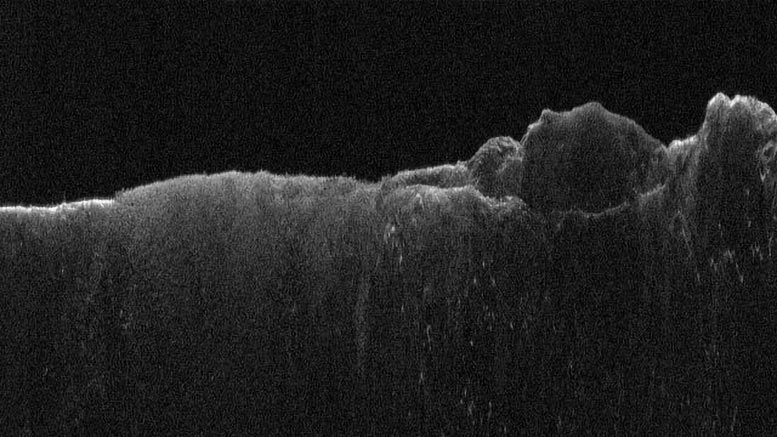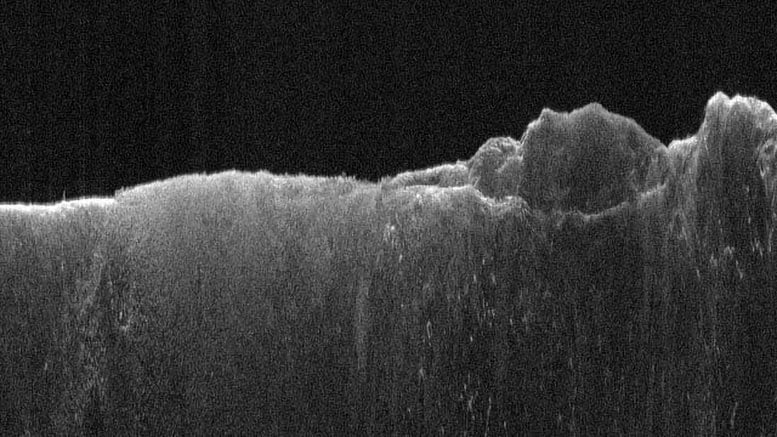
NASA’s Mars Reconnaissance Orbiter has learned to pull off daring 120-degree rolls that give its SHARAD radar ten-times-stronger echoes, exposing hidden ice and geology more than a mile underground.
Engineers painstakingly schedule these flips to keep solar arrays powered and antennas linked while juggling five competing instruments. The fresh trick revives a 19-year-old spacecraft, even helping the Mars Climate Sounder stay in action after its pivot failed, and promises a richer view of the Red Planet’s resources, climate, and past habitability.
MRO Rolls for Deeper Science
After nearly 20 years of exploring Mars, NASA’s Mars Reconnaissance Orbiter (MRO) is proving it still has a few surprises left. Engineers have recently taught the spacecraft a bold new move, rolling nearly upside down, to unlock a deeper view beneath the Martian surface. This new maneuver allows MRO to search even more effectively for signs of liquid and frozen water, along with other buried features that could reveal Mars’ hidden history.
The breakthrough is highlighted in a new paper published in the Planetary Science Journal, which describes three of these dramatic “very large rolls” carried out between 2023 and 2024.
This animation depicts NASA’s Mars Reconnaissance Orbiter performing a 120-degree roll that increases the strength of its radar signal by 10 times or more. Credit: NASA/JPL-Caltech
Teaching the Orbiter New Moves
“Not only can you teach an old spacecraft new tricks, you can open up entirely new regions of the subsurface to explore by doing so,” said one of the paper’s authors, Gareth Morgan of the Planetary Science Institute in Tucson, Arizona.
MRO was originally built to roll up to 30 degrees in any direction, allowing it to aim its instruments at features like impact craters, ancient riverbeds, and potential landing sites. But now, engineers have pushed it even further.
“We’re unique in that the entire spacecraft and its software are designed to let us roll all the time,” said Reid Thomas, MRO’s project manager at NASA’s Jet Propulsion Laboratory (JPL) in Southern California.
Coordinating Complex Spacecraft Rolls
The process for rolling isn’t simple. The spacecraft carries five operating science instruments that have different pointing requirements. To target a precise spot on the surface with one instrument, the orbiter has to roll a particular way, which means the other instruments may have a less-favorable view of Mars during the maneuver.
That’s why each regular roll is planned weeks in advance, with instrument teams negotiating who conducts science and when. Then, an algorithm checks MRO’s position above Mars and automatically commands the orbiter to roll so the appropriate instrument points at the correct spot on the surface. At the same time, the algorithm commands the spacecraft’s solar arrays to rotate and track the Sun and its high-gain antenna to track Earth to maintain power and communications.
Very large rolls, which are 120 degrees, require even more planning to maintain the safety of the spacecraft. The payoff is that the new maneuver enables one particular instrument, called the Shallow Radar (SHARAD), to have a deeper view of Mars than ever before.

Sharper Radar Insights Underground
Designed to peer from about half a mile to a little over a mile (1 to 2 kilometers) belowground, SHARAD allows scientists to distinguish between materials like rock, sand, and ice. The radar was especially useful in determining where ice could be found close enough to the surface that future astronauts might one day be able to access it. Ice will be key for producing rocket propellant for the trip home and is important for learning more about the climate, geology, and potential for life at Mars.
But as great as SHARAD is, the team knew it could be even better.
Overcoming Signal Interference
To give cameras like the High-Resolution Imaging Science Experiment (HiRISE) prime viewing at the front of MRO, SHARAD’s two antenna segments were mounted at the back of the orbiter. While this setup helps the cameras, it also means that radio signals SHARAD pings onto the surface below encounter parts of the spacecraft, interfering with the signals and resulting in images that are less clear.
“The SHARAD instrument was designed for the near-subsurface, and there are select regions of Mars that are just out of reach for us,” said Morgan, a co-investigator on the SHARAD team. “There is a lot to be gained by taking a closer look at those regions.”
In 2023, the team decided to try developing 120-degree very large rolls to provide the radio waves an unobstructed path to the surface. What they found is that the maneuver can strengthen the radar signal by 10 times or more, offering a much clearer picture of the Martian underground.
Power, Communication, and Risk Balance
But the roll is so large that the spacecraft’s communications antenna is not pointed at Earth, and its solar arrays aren’t able to track the Sun.
“The very large rolls require a special analysis to make sure we’ll have enough power in our batteries to safely do the roll,” Thomas said.
Given the time involved, the mission limits itself to one or two very large rolls a year. But engineers hope to use them more often by streamlining the process.
Climate Sounder Adapts to Rolls
While SHARAD scientists are benefiting from these new moves, the team working with another MRO instrument, the Mars Climate Sounder, is making the most of MRO’s standard roll capability.
The JPL-built instrument is a radiometer that serves as one of the most detailed sources available of information on Mars’ atmosphere. Measuring subtle changes in temperature over the course of many seasons, Mars Climate Sounder reveals the inner workings of dust storms and cloud formation. Dust and wind are important to understand: They are constantly reshaping the Martian surface, with wind-borne dust blanketing solar panels and posing a health risk for future astronauts.
Mars Climate Sounder was designed to pivot on a gimbal so that it can get views of the Martian horizon and surface. It also provides views of space, which scientists use to calibrate the instrument. But in 2024, the aging gimbal became unreliable. Now Mars Climate Sounder relies on MRO’s standard rolls.
“Rolling used to restrict our science,” said Mars Climate Sounder’s interim principal investigator, Armin Kleinboehl of JPL, “but we’ve incorporated it into our routine planning, both for surface views and calibration.”
Reference: “SHARAD Illuminates Deeper Martian Subsurface Structures with a Boost from Very Large Rolls of the MRO Spacecraft” by Nathaniel E. Putzig, Gareth A. Morgan, Matthew R. Perry, Bruce A. Campbell, Jennifer L. Whitten, Fabrizio Bernardini, Alessandro DiCarlofelice, Piero Tognolatti and Pierfrancesco Lombardo, 11 June 2025, The Planetary Science Journal.
DOI: 10.3847/PSJ/addbe1
NASA’s Mars Reconnaissance Orbiter (MRO) is a long-running spacecraft mission dedicated to studying the Red Planet from orbit. Launched in 2005 and managed by NASA’s Jet Propulsion Laboratory (JPL) in Southern California for the agency’s Science Mission Directorate, MRO is part of NASA’s broader Mars Exploration Program. It plays a key role in analyzing Mars’ surface, atmosphere, and subsurface using a suite of advanced instruments.
One of MRO’s standout tools is SHARAD (Shallow Radar), which probes beneath the Martian surface to detect features like ice and rock layers. Provided by the Italian Space Agency and operated by Sapienza University of Rome, SHARAD is a collaborative effort analyzed by a joint U.S.-Italian science team, with U.S. participation led by the Planetary Science Institute in Tucson, Arizona.
Lockheed Martin Space, based in Denver, built the orbiter and continues to support its operations, ensuring the spacecraft’s longevity and scientific productivity well into its second decade.
Never miss a breakthrough: Join the SciTechDaily newsletter.

12 Comments
Love those photos. Keep up the great work NASA
Lol, what a load of crap. People will believe anything, one thing i can say about humans is we are a trusting bunch, are we not. LMFAO
I’m not the world’s biggest fan of NASA. I think that they suffer from ‘Mission Creep” and political correctness. However, I’m perplexed at your unspecific criticism. Just what are you unhappy with?
If you don’t understand what it’s saying, then just say you don’t understand. No need to make fun of something because you think the rest of us don’t understand it either. Your confidence in your comment
Is extremely unnerving.
Maybe I should try whatever it is your smoking!
Adjusting the roll of the spacecraft for that it’s radar can get a clear penetration of the ground without having to deal with the noise or interference of the other parts of the spacecraft that would normally be in the way is a brilliant way to get a much better and clearer image.
Or, let me explain it like this: If you take a picture on a foggy day from far away your image won’t be very clear. If you take the picture on a clear day with high visibility your picture will be,
“Like. HI-DEF, man 🤟”
“There’s like, nothing in the way, dude 🤙”
🙄😎🥸🤯
How do you come to this conclusion?
Facts please. No emotional opinions, since opinions have absolutely nothing to do with the facts.
Let’s Dig Another .5 mile, And We Find The First Skyscraper. That Would Blow Everyone Minds. To Think Mars Held Life Like Ours. It’s Amazing With The 60s Technology Landing On The Moon. Jus Think China Will Have Homes For Rent, As They Have The Moon Rover Roped Off. To Prove Once For All.
What is that all about? Your comment is incoherent.
We are spending a fortune on other planets while ours falls apart. Seems like a very stupid waste of money to me. Much as I am fascinated by space exploration I would give that a miss to fix global warming. Or is it now impossible to stop. What happened to Joe Biden’s promise to shield the Poles with reflective droplets?
.
“What happened to Joe Biden’s promise to shield the Poles with reflective droplets?”
Biden’s doctor pleaded the 5th Amendment when asked about what he knew about Biden’s mental state while president. That is legal, but not good optics. You apparently trusted a former lawyer-turned politician to actually understand our climate system well enough to know how to address concerns about so-called anthropogenic global warming. Does it actually seem reasonable that someone, who does not have an Earth Science background and is certifiably dealing with advanced senility, can judge scientific disagreements about the state of the climate?
You apparently have accepted the claim that the Earth is warming solely because of anthropogenic CO2 emissions. Can you explain why the smoothly increasing annual concentration of CO2 results in global temperatures that not only go up and down randomly, but more importantly, have a step up every 3 or 4 years when there is an El Nino event for a few months? That is, where did the ocean heat come from? Or, why the increase in atmospheric temperatures precedes the seasonal CO2 ramp-up by increasing the slope and peak of the concentration curve? Or, why the temperatures derived from Antarctic ice cores show 800,000-years of changes in temperature preceded changes in CO2? Lastly, why during the COVID shutdowns, which at a monthly temporal resolution that reached at least -14% during April, there is no obvious difference in the slope or peak of the seasonal ramp of phase of 2020 compared to 2019 or 2021?
Sounds like a roll of crap to me
Does your opinion have the weight of any facts or logic to support it?
Such funny people